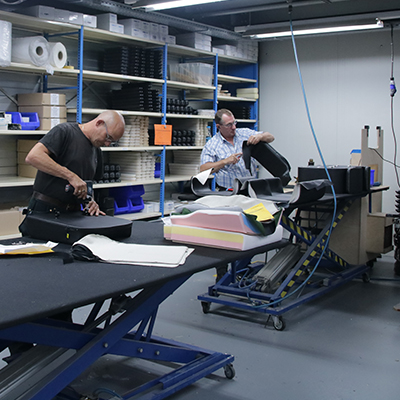Downloads
On this page you can download all the files that are collected at the Pro Seating® website.
Click on a file to download it.
- Productlist Pro Seating®
- Returns and customer complaints form
- Terms and conditions Pro Seating®
- CSR statement
Certificates
Ignitability
It is compulsory for all upholstery materials used for wheelchair cushions to be tested and approved
in accordance with European standard no. EN 1021-1&2. This standard includes two tests to which materials are subjected: a smouldering cigarette test and a flame test.
The cigarette test assesses the ignitability of the combination of upholstery and foam materials used when exposed to a smouldering cigarette. No ignition of the materials may be observed.
In the flame test, the same method is used but instead with a butane flame directed at the material for 15 seconds. In this case, too, no continuing flaming may be observed and any fire must go out by itself within 120 seconds.
- Fire retardancy certificate Pro Skin®
- Fire retardancy certificate Pro Incon®
- Fire retardancy certificate Pro Velour®
- Fire retardancy certificate Pro Air®
- Fire retardancy certificate terry cloth
- Fire retardancy certificate Ambla Tinto Nubian
- Fire retardancy certificate Pampa leather
- Fire retardancy certificate Velcro loop
- Fire retardancy certificate Bayfit
Biocompatibility
It is compulsory for upholstery materials used for wheelchair cushions and other positioning
aids which come into direct or indirect contact with the body of the medical device’s user to be assessed for any biological risks for the user. First, an assessment is made of the risks of the application. Where upholstery materials for wheelchairs are concerned, this means testing in accordance with ISO 10993-5 to demonstrate biocompatibility. There is therefore no need for
tests to be carried out on living animals.
During the test, a piece of the upholstery material is put into a liquid for a set period of time.
Some of the resulting solution is then transferred to specially prepared culture dishes containing
cell cultures. The dishes are kept in a controlled environment for a set period of time and are then
examined in a laboratory to see what influence the test solution has had on the cell culture. If a reduction of more than 30% in the viability of the cell culture is observed, then the material is said
to have had a cytotoxic effect and as such fails the test.
















